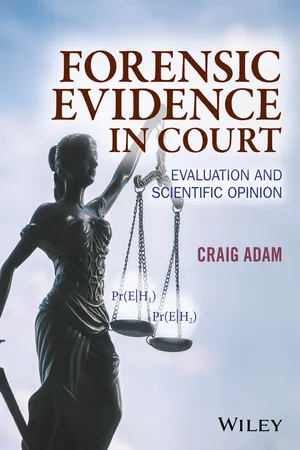
- English
- ePUB (mobile friendly)
- Available on iOS & Android
About this book
The interpretation and evaluation of scientific evidence and its presentation in a court of law is central both to the role of the forensic scientist as an expert witness and to the interests of justice. This book aims to provide a thorough and detailed discussion of the principles and practice of evidence interpretation and evaluation by using real cases by way of illustration. The presentation is appropriate for students of forensic science or related disciplines at advanced undergraduate and master's level or for practitioners engaged in continuing professional development activity.
The book is structured in three sections. The first sets the scene by describing and debating the issues around the admissibility and reliability of scientific evidence presented to the court. In the second section, the principles underpinning interpretation and evaluation are explained, including discussion of those formal statistical methods founded on Bayesian inference. The following chapters present perspectives on the evaluation and presentation of evidence in the context of a single type or class of scientific evidence, from DNA to the analysis of documents. For each, the science underpinning the analysis and interpretation of the forensic materials is explained, followed by the presentation of cases which illustrate the variety of approaches that have been taken in providing expert scientific opinion.
Frequently asked questions
- Essential is ideal for learners and professionals who enjoy exploring a wide range of subjects. Access the Essential Library with 800,000+ trusted titles and best-sellers across business, personal growth, and the humanities. Includes unlimited reading time and Standard Read Aloud voice.
- Complete: Perfect for advanced learners and researchers needing full, unrestricted access. Unlock 1.4M+ books across hundreds of subjects, including academic and specialized titles. The Complete Plan also includes advanced features like Premium Read Aloud and Research Assistant.
Please note we cannot support devices running on iOS 13 and Android 7 or earlier. Learn more about using the app.
Information
Part 1
1
An Introduction to the Admissibility of Expert Scientific Opinion
1.1 Admissibility, Reliability and Scientific Evidence
- Is the evidence admissible to the court?Admissibility includes whether the evidence is relevant to and therefore has value for the legal debate (probative value), as well as a variety of other factors such as the status of the expert witness, the quality of the methodology and the underpinning science. Admissibility is determined by the judge and is categorical, since the expert witness will either be permitted or not permitted to give their testimony. The judge is said, by some legal authorities, to act as a ‘gatekeeper’ for expert evidence. The judge’s decision on admissibility and the grounds for that conclusion is crucial to the legal process.
- Is the evidence reliable?Reliability may contribute to admissibility but is itself a complex concept which is subject to considerable variation in how it is dealt with across courts and jurisdictions. At a basic level, the court has to assess the validity of the scientific methodology and whether the evaluation delivered by the expert is soundly based on the results of their work. However, the extent to which this contributes to admissibility or whether reliability may instead be a factor in deciding the legal weight of the evidence is open to debate. Therefore, it is the degree of reliability and not necessarily whether evidence is reliable or unreliable that matters. The significance of these two factors has been summarised by Susan Haack in the phrase:‘Admissibility is categorical, reliability is continuous’[Haack, quoted in Cole, 2007]
- Has the significance of the evidence been properly assessed, then communicated to and understood by, the court?It is the responsibility of the scientist to design and carry out experimental measurements, to analyse results and then to interpret what they mean in the context and circumstances of the case. However, as an expert witness, the interpretation of this work must be presented to the court so that the judge, the jury and the legal professionals may fully understand its significance to their debate. The extent to which this may be achieved and the manner in which it is done varies hugely across the subdisciplines of forensic science, between individual scientists and across courts and jurisdictions. The process of the evaluation and presentation of scientific evidence forms the discussion in the main section of this book.
1.2 The Impact of the DNA Revolution
Table of contents
- Cover
- Title Page
- Table of Contents
- Preface
- Part 1
- Part 2
- Part 3
- Appendix: Some Legal Terminology
- Index of Cases, Individuals and Inquiry Reports
- General Index
- End User License Agreement